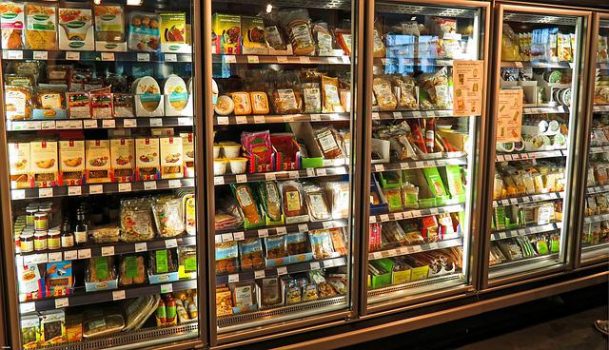Storing Food – The Basics
Storing Food – The Basics.In the refrigerator
Food stored in the refrigerator or freezer should be stored in tightly wrapped containers such as cellophane and aluminum foil or in sealed containers such as ziplock bags and plastic bowls with lids and locking mechanism. A suggested padlock to prevent your children and spouse from eating your favorite ice cream. The main point is that the food is sealed; nothing goes in nothing goes out.
Sealed foods effectively lock in flavor and moisture, and thwart any attempts at other foods where juices drip and stronger flavors seep in and transfer to foods that are not in them. Not to mention makes the fridge cooler and a lot easier to clean.
It is important to keep raw meat and poultry as sealed as possible because they tend to leak and introduce bacteria into your under cooked food or even your leftovers. This can cause a common illness known as “food poisoning”.
Perishable foods should be stored at 35 to 0 degrees F for maximum freshness. These foods include but are not limited to all meats (beef, pork, poultry, freshwater fish and seafood), eggs, all dairy products (milk, cheese, yogurt, etc.), most fruits and most vegetables.
Why does refrigeration or refrigeration help preserve food? Well, the basic science is simple. Temperature is a measurement that tells us how fast molecules are moving. The refrigerator is a tool that slows down the molecules in food, thereby reducing the rate at which food spoils. The hotter the food, the faster it spoils, which is why freezing our food is so beneficial. Freeze foods below 0 degrees F for longer shelf life.
In contrast, freezing or “freezing tissue destruction” is where the molecules of living matter such as meat slow down to the point where they lose their molecular bonds and break down. This is what happens when something breaks. So frost burn on meat or any food is really frozen rot, rancid, don’t eat.
However, refrigerator manufacturers still see no reason to incorporate thermometers to tell us what temperature our food is at. Instead, they use this dial with a red and blue number or image indicating cooler or warmer. The rotary knob only controls the cooling of the food and does not tell us what temperature the refrigerator is at.
So whether storing, preparing or serving your food, it is essential to keep it at the right temperature. Get yourself a nice freezer and fridge thermometer. Don’t be weird about the temperature of your food, just keep an eye on things. You will notice that because the refrigerator is controlled by a knob, it cools at the same rate regardless of the actual temperature inside the refrigerator, so in winter you may have to turn the knob down to not freeze milk.
Storing fresh fruit
Fruit that can be stored at room temperature during ripening includes, but is not limited to, apricots, kiwis, mangoes, nectarines, papayas, peaches, pears, pineapples and plum. When they’re ripe, refrigerate and consume within 2-3 days for maximum freshness.
Apples stored in the refrigerator will stay crisp longer, but can be stored at cool room temperature. Other fruits that can be stored at cool room temperature include bananas, dates, lemons, limes, grapefruit, and oranges. Apples can be stored at this temperature for several days, citrus fruits up to a week, and dates for several weeks, no longer than in your refrigerator.
Ripe fruits include, but are not limited to, berries, cherries, figs, grapes, melons, pomegranates and tangerines. These should be refrigerated and consumed within 2-3 days. Grenades seem to last longer, but don’t wait too long, they can get expensive.
Storing fresh vegetables
Many vegetables can be stored at room temperature or in the refrigerator. However, it is ideal for many vegetables to be in a dark, ventilated room at 50 degrees Fahrenheit. These vegetables include chayote, garlic, onions, potatoes and sweet potatoes, rutabaga, and winter squash. These vegetables can be kept in this medium for about 2 months.
Remember that a tomato is technically a fruit, not a vegetable, regardless of its taste or the type of plant it grows on. Tomatoes should be cooked at room temperature and then refrigerated.
Some vegetables spoil faster than others and need to be refrigerated; Peas and corn should be eaten as soon as possible while carrots and cabbage can be stored longer. In most cases, do not wash vegetables until you are ready to serve and eat, this helps prevent mold and rotting. However, it is necessary to wash celery, cabbage, bok choy, greens, herbs, lettuce, spinach and watercress before storing.
Canned and Dry Food Storage
Having a well-stocked pantry can be both joy and peace of mind. However, letting your canned food dry past its expiration date or even past its fresh date may not be good for cooking to preserve flavor and nutrition. These foods should be stored in a cool, dry refrigerator at a temperature not exceeding 65 degrees F. Necessary items such as flour, salt, sugar, pasta and cereals should be sealed in a moisture-proof container.
Additionally, transferring these items into leak- and spill-proof containers such as jars and plastic tubs can greatly improve organization and make cleaning up your cabinets easier. Refined grains tend to last longer than whole grain products, so keep an eye on your whole wheat flour and brown rice, which may come in clear containers.
To add protein to your diet, open all your bags and boxes of dry goods. Wait for the hoe saturation to peak, then cook and serve, delicious! There’s nothing like wheat pancakes and a few small pastries.
Dried herbs and spices keep the best value in your cooking endeavors in sealed jars. Light is the enemy here store your precious herbs in a dark place in a sealed jar, glass or ceramic if possible. The oils are all the same, except guaranteed




